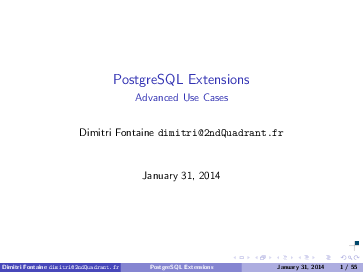
Back from the FODESM 2014 Conference, here’s the slides I’ve been using for the Advanced Extension Use Cases talk I gave, based on the ongoing work to be found under the Tour of Extensions index in this web site.
If you’re interested into the talk contents, then you might be interested into the following list of articles where I actually did all the work leading to the slides in the above PDF:

Last week I had the pleasure to present two talks at the awesome PostgreSQL Conference Europe. The first one was actually a tutorial about Writing & using Postgres Extensions where we spent 3 hours on what are PostgreSQL Extensions, what you can expect from them, and how to develop a new one. Then I also had the opportunity to present the new version of pgloader in a talk about Migrating from MySQL to PostgreSQL.

In our Tour of Extensions today’s article is about advanced tag indexing. We have a great data collection to play with and our goal today is to be able to quickly find data matching a complex set of tags. So, let’s find out those lastfm tracks that are tagged as blues and rhythm and blues, for instance.
We’re going to use the Last.fm dataset from the Million Song Dataset project here.

At the Open World Forum two weeks ago I had the pleasure to meet with Colin Charles. We had a nice talk about the current state of both MariaDB and PostgreSQL, and even were both interviewed by the Open World Forum Team. The interview is now available online. Dear French readers, it’s in English.
Here’s the video:
Executive Summary: MariaDB is a drop-in fully Open Source replacement for MySQL and sees quite some progress and innovation being made, and PostgreSQL is YeSQL!

PostgreSQL is an all round impressive Relational DataBase Management System which implements the SQL standard (see the very useful reference page Comparison of different SQL implementations for details). PostgreSQL also provides with unique solutions in the database market and has been leading innovation for some years now. Still, there’s no support for Autonomous Transactions within the server itself. Let’s have a look at how to easily implement them with PL/Proxy.
